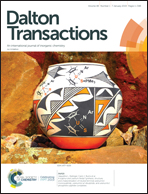Abstract
Ferrocene-based Lewis bases have found utility as metalloligands in a wide variety of applications. The coordination chemistry of cyanoferrocenes however, is underexplored. Herein, we describe a new synthetic protocol for the generation of cyanoferrocenes. The coordination chemistry of these metalloligands to [Cu(NCMe)4][PF6], [(PPh3)2Cu(NCMe)2][PF6] and [(dppf)Cu(NCMe)2][PF6] salts has been explored, providing crystallographic evidence of cluster and polymeric forms of 1,1′- and 1,2-dicyanoferrocene complexes. The stability of the complexes and ligand dissociation were found to be strongly solvent-dependent.



 Please wait while we load your content...
Please wait while we load your content...